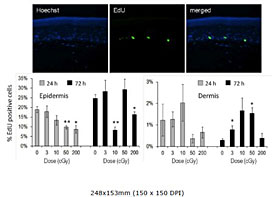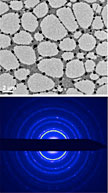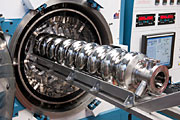- Number 364 |
- June 4, 2012
-
Targets of ionizing radiation identified in a human skin model
 Very low doses of ionizing radiation can change the structure and possibly the function of proteins that reside in human skin cells, according to scientists at DOE's Pacific Northwest National Laboratory. Low doses of ionizing radiation are often encountered, such as going into the hospital and receiving a full body CT scan. In addition to identifying proteins changed by the radiation, the team showed that the study’s reconstituted human skin system responds in a coordinated fashion to maintain tissue integrity and mitigate exposure effects.
Very low doses of ionizing radiation can change the structure and possibly the function of proteins that reside in human skin cells, according to scientists at DOE's Pacific Northwest National Laboratory. Low doses of ionizing radiation are often encountered, such as going into the hospital and receiving a full body CT scan. In addition to identifying proteins changed by the radiation, the team showed that the study’s reconstituted human skin system responds in a coordinated fashion to maintain tissue integrity and mitigate exposure effects.
Using resources in DOE's EMSL to identify proteins affected by radiation exposure, the scientists found 1052 protein modifications in the skin model. These modifications involve adding or removing a phosphate group on proteins, a critical change that alters protein function, enabling cells to rapidly respond to the environment. -
Fermilab adds sparkle to new generation of particle accelerators
A new generation of powerful accelerators relies on superconducting niobium cavities as the technology of choice. These devices can propel more particles in a shorter distance than conventional accelerator technologies.
At DOE’s Fermi National Accelerator Laboratory, scientists are collaborating with industry and national laboratories to optimize manufacturing processes for these cavities and build an advanced prototype accelerator. The research helps reduce the cost of these accelerators and paves the way for future applications. -
Scientists uncover a photosynthetic puzzle
Quantum physics and plant biology seem like two branches of science that could not be more different, but surprisingly they may in fact be intimately tied.
Researchers at DOE's Argonne National Laboratory and the Notre Dame Radiation Laboratory at the University of Notre Dame used ultrafast spectroscopy to see what happens at the subatomic level during the very first stage of photosynthesis. "If you think of photosynthesis as a marathon, we're getting a snapshot of what a runner looks like just as he leaves the blocks," said Argonne biochemist David Tiede. "We're seeing the potential for a much more fundamental interaction than a lot of people previously considered." -
CEBAF upgrade test a success
DOE's Jefferson Lab is in the midst of a $310 million upgrade project to provide physicists worldwide with an unprecedented ability to study the basic building blocks of matter. Now, key components of the upgrade to the lab’s particle accelerator have aced a rigorous test conducted under real operating conditions, confirming that the newly designed, state-of-the art components meet specification.
The lab's CEBAF accelerator delivers beams of electrons for probing the protons, neutrons, quarks and gluons in the nucleus of the atom. The upgrade will enhance the research capabilities of the accelerator by doubling the energy of its electron beam from 6 billion electron-Volts (GeV) to 12 GeV, along with other upgrades and additions. To increase the energy of the CEBAF accelerator, 10 new sections, called cryomodules, will be added.





